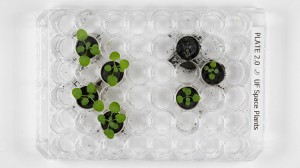Moon Salad on the Menu
Thursday, May 26th, 2022
Plants grown in simulated lunar soil on the left and in Apollo sample on the right, seen 16 days after planting.
Credit: Tyler Jones, UF/IFAS
Well, not exactly. Scientists recently grew plants in lunar soil for the first time in history. The lunar soil, also called moon dust, was brought back from three Apollo missions. Scientists from the University of Florida planted thale cress in the moon dust and compared the growth to materials found on Earth’s surface, such as volcanic ash. Thale cress is a small, bitter-tasting plant similar to broccoli, cauliflower, and kale. After two days, the seeds had germinated (grown). However, the plants in moon soil did not thrive compared to the plants in Earth soil after six days.
Lunar soil is very different from the soil on Earth. Soil is the mixture of minerals, organic matter, and other materials that covers most of Earth’s land. Soil is a storehouse of nutrients and the decayed remains of organisms (living things). Lunar soil is more dusty and is not made up of decayed organisms, so it does not contain as many nutrients compared to soil found on Earth. Impacts of micrometeoroids (tiny meteoroids‘) grind the surface rocks into a fine, dusty powder known as regolith. Regolith overlies all the bedrock on the moon. Because regolith forms as a result of exposure to space, the longer a rock is exposed, the thicker the regolith that forms on it.
National Aeronautics and Space Association (NASA) granted the scientists 12 grams of lunar soil for the experiment because it is precious and cannot be wasted. The soil brought back from Apollo 11 was not as strong as the soil brought back from Apollo 12 and 17. The scientists believe soil from Apollo 11 was damaged by cosmic rays and radiation from solar wind on the moon’s surface. Scientists have already started planning where they could find better moon soil where lava flow has enriched the soil.
For years, scientists have wondered whether the moon could support life. If humans were to survive on the moon permanently, they would need to grow plants for food. Although the experiment did not prove that the moon could sustain life, it gives hope that there could be vegetation on the moon someday. We are one step closer to growing an herb garden on the moon!


